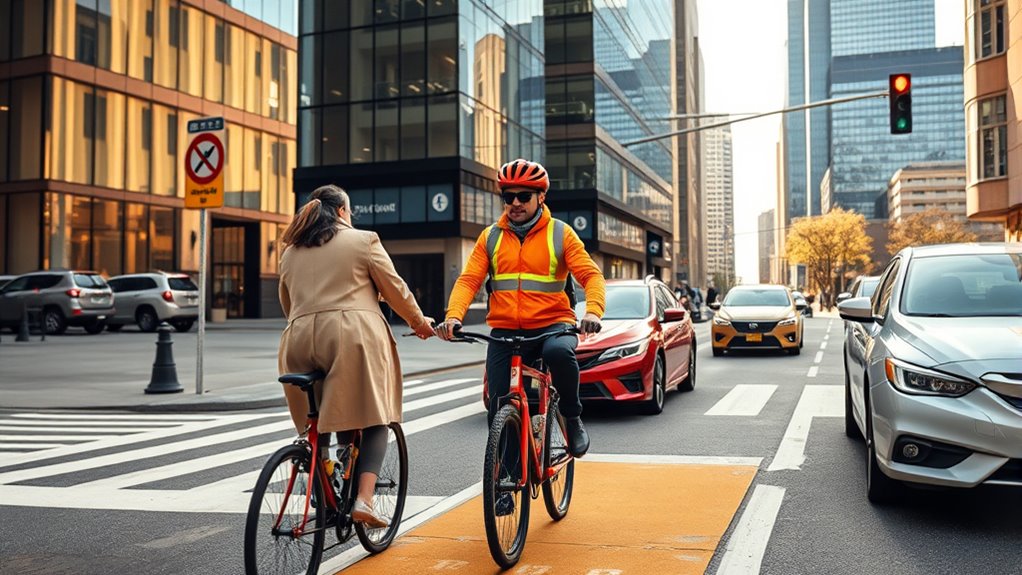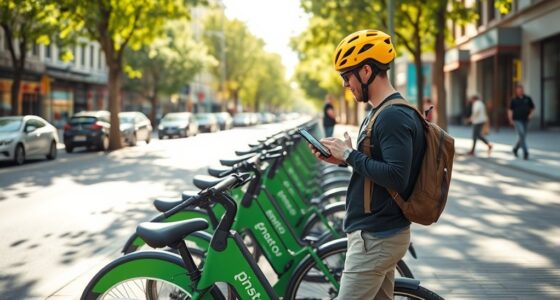To share the road politely with cars and pedestrians, signal your intentions clearly with hand signals and use your bell or horn sparingly. Always stay alert, watching for obstacles and pedestrians, while maintaining steady speed in crowded areas. Yield the right of way to pedestrians at crosswalks, stay within designated bike lanes, and follow traffic rules. Practicing patience and courtesy helps make urban cycling safer and more enjoyable—keep going to learn even more tips for respectful riding.
Key Takeaways
- Signal intentions clearly with hand signals and use the bell or horn sparingly to alert others.
- Maintain awareness of your surroundings, follow traffic signals, and stay within designated bike lanes.
- Yield to pedestrians at crosswalks and sidewalks, slowing down or dismounting if needed.
- Keep to the right and avoid sudden lane changes to ensure safe passing and prevent confusion.
- Practice patience and courtesy, giving space and remaining calm in interactions with all road users.

Urban cycling can be an enjoyable and efficient way to navigate city streets, but it requires awareness of proper etiquette to guarantee safety and harmony among all road users. When you ride through busy streets, you’re sharing space with cars, pedestrians, and other cyclists. Respecting their presence is essential to ensure everyone stays safe and comfortable. First, always be predictable. Signal your intentions clearly with hand signals before turning or stopping. Use your bell or horn sparingly to alert pedestrians or other cyclists of your approach, especially when passing in tight spots. Making your movements predictable helps prevent unexpected surprises that could lead to accidents.
Be predictable: signal intentions clearly and use your bell sparingly to ensure safe, harmonious urban cycling.
Next, stay aware of your surroundings. Keep your eyes on the road and scan ahead for obstacles, pedestrians stepping into your path, or vehicles pulling out of driveways. Avoid distractions like using your phone or listening to music with headphones, as these can impair your ability to react quickly. Maintaining situational awareness is crucial for reacting to sudden changes in your environment. Being mindful of your surroundings enhances your capacity to respond promptly to hazards. Also, being aware of traffic signals and signs helps you follow the rules of the road and anticipate other drivers’ actions. Maintaining a steady, controlled speed, especially when riding through crowded areas or near pedestrians. Speeding can startle others and increase the risk of collisions. Be particularly cautious around pedestrians, giving them ample space and slowing down in crowded sidewalks or parks. Being mindful of your input lag can help you react more swiftly to sudden changes in your environment.
Respect pedestrian right of way. When sharing crosswalks or sidewalks, yield to pedestrians at all times. If you need to cross a sidewalk, slow down and dismount if necessary, so you can walk your bike across. Similarly, when riding on bike lanes or designated cycling routes, stay within the designated space and avoid encroaching on pedestrian zones. Straying outside your lane can create confusion and potential conflicts. Always stay to the right (or designated side), allowing faster cyclists or vehicles to pass on your left. If you’re riding in a group, stay close together, but don’t block entire lanes or sidewalks, making it difficult for others to pass.
Finally, be courteous and patient. Not everyone on the road is as experienced or aware as you are. If someone makes a mistake or doesn’t follow cycling etiquette, resist the urge to get angry or confrontational. Instead, give them space and proceed calmly. Remember, your behavior influences others and encourages a respectful cycling environment. Additionally, practicing mindfulness and presence can help you stay focused and aware during your ride. By following these etiquette principles, you contribute to safer, more enjoyable urban riding for everyone. Your awareness and consideration foster a city where cyclists, drivers, and pedestrians coexist harmoniously, making urban cycling a positive experience for all.
Frequently Asked Questions
How Should Cyclists Handle Aggressive Drivers?
When you encounter aggressive drivers, stay calm and avoid escalating the situation. Keep your distance and don’t make eye contact or respond to their behavior. Use hand signals clearly to communicate your intentions, and if possible, move to a safer area or slow down. Remember, your safety is the priority. Reporting aggressive drivers to authorities can help prevent future incidents and keep the road safer for everyone.
Are There Specific Rules for Riding in Bike Lanes?
When riding in bike lanes, you should stay within the designated space and ride in a straight line, avoiding sudden swerves. Keep an eye out for parked cars to avoid opening doors and signal your intentions when turning or changing lanes. Obey traffic signals and stop signs just like drivers, and be courteous to pedestrians crossing at intersections. Following these rules helps keep you safe and shows respect for others sharing the lane.
How Do Cyclists Signal Turns Effectively?
You can signal turns effectively by using clear, intentional gestures. When preparing to turn, extend your arm straight out for a left turn, or bend your arm upward for a right turn. Make your signals well in advance of the turn, so others know your intentions. Keep your signals steady and visible, and always check behind you before making the move. This guarantees safety and smooth communication with drivers and pedestrians alike.
What Should Pedestrians Do When Cyclists Ride Unpredictably?
When cyclists ride unpredictably, you should stay alert and keep a safe distance to avoid accidents. If they suddenly veer or slow down, slow your pace and give them space. Make eye contact if possible to understand their intentions. If you’re unsure of their next move, it’s best to wait patiently until they stabilize. Staying attentive and respectful guarantees everyone’s safety on busy urban streets.
Are There Age Restrictions for Urban Cycling?
You might wonder if there are age restrictions for urban cycling. Usually, children can start riding with proper safety gear and supervision, while many cities don’t impose strict age limits. However, local laws vary, so you should check your area’s regulations. As long as you’re comfortable and follow safety guidelines, cycling can be a great activity regardless of age. Just stay alert, wear a helmet, and enjoy your ride safely.
Conclusion
Think of the streets as a lively river where bikes, cars, and pedestrians flow together. By respecting each other’s space and following the rules, you become a skilled kayaker, guiding the current smoothly. When you ride mindfully, you help keep the river safe and enjoyable for everyone. Embrace your role as a courteous navigator, and you’ll guarantee the journey remains harmonious—making every ride a pleasant adventure for all on this shared road.









